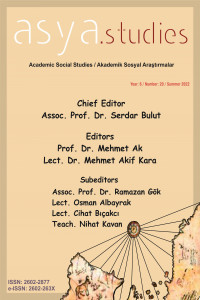TRAVMA SONRASI STRES BOZUKLUĞUNDA MEDYANIN ROLÜ
İnsan tüm hayatı boyunca farklı yaşam deneyimlerinden geçmektedir. Bu deneyimlerin büyük kısmı kaygılanmasına neden olurken, kişi bu kaygıyla baş edebilmek için çeşitli savunma mekanizmaları kullanmakta ve bu sayede herhangi bir problem ve kriz yaşanmadan günlük hayatına devam etmektedir. Bazı yaşam deneyimleri karşısında savunma mekanizmalarımız yetersiz kalabilir ve işte o zaman bir kriz dönemi ortaya çıkmakta, krize neden olan bu olaylara travma deneyimi adı verilmektedir. Bu çalışmada; deprem bölgesinde yaşamadığı ve depremden etkilenmediği halde 17 Ağustos 1999 tarihinde yaşanan Gölcük Depremi görüntülerini çeşitli televizyon kanallarından izlemelerinin ardından, ruhsal şikâyetlerle tarafımıza müracaat eden olguların psikiyatrik tanı dağılımı açısından araştırılması ve medya olanaklarının böylesine toplumsal travmatik olaylarda doğru kullanılmasının tartışılması amaçlanarak metodoloji oluşturulmuştur.
Anahtar Kelimeler:
Travma, Medya, Stres Bozukluğu, İletişim, Toplumsal Ruh Sağlığı
THE MEDIA’S ROLE IN POST-TRAUMATIC STRESS DISORDER
One goes through different life experiences through her whole life. While some of these experiences cause anxiety, the person uses various defence mechanisms to deal with it, hence is able to continue their daily life without having any problems or crisis. These defence mechanisms may prove to be insufficient against some life experiences and then a crisis occurs. These events that cause the crisis are called trauma experiences. In this paper, even though they didn't live in the earthquake zone or be affected by it, after they watched the Golcuk Earthquake on 17th of August 1999 from TV channels, methodology has been created to discuss the correct use of media in traumatic events like these and to research on the psychiatric diagnosis breakdown of the people who applied to us with mental illnesses.The methods of “Clinician-Administered PTSD Scale” ( CAPS-I)** “The Hamilton Depression Rating Scale” (HAMD)***“The Beck Anxriety Inventory” (BAÖ)**** “Impact of Events Scale (IES)***** have been used to the ones who didn't have any psychiatric complaints until the earthquake and after application, following the clinic tests and diagnosis with “Structured Clinical Interview for DSM-III-R*” (SCID-I)* to 10 subjects. 7 of these subjects have been diagnosed with PTSD (post-traumatic stress disorder) and 3 of them with depression. The subjects who were diagnosed with PTSD have scored high on CAPS, IES AND BAO. While HAMD points have been very high on the ones who were diagnosed with depression, BAO points have also been high.
Keywords:
Trauma, Media, Stress Disorder, Communication, Community Mental Health,
___
- Akdemir A., Örsel S., Dağ İ., Türkçapar H., İşcan N., Özbay H.(1996). Hamilton Derecelendirme Ölçeği Geçerliği, Güvenirliği ve Klinikte Kullanımı. Psikiyatri Psikoloji Psikofarmakoloji Dergisi. 4(4): 251-259.
- Aker A.T., Özeren M., Başoğlu M., Kaptanoğlu C., Erol A., Buran B.(1994). CAPS Skalası Geçerliği, Güvenirliği ve Klinikte Kullanımı. Türk Psikiyatri Dergisi; 286-293.
- American Psychiatric Association(1994). Diagnostic and Statistical Manual of Mental disorders. Fourth Edition (DSM-IV), Washington DC, American Psychiatric Association.
- Blanchard E.B., Kolb L.C., Gerardi R.J.(1986). “Cardiac Response To Relevant Stimuli As An Adjunctive Tool For Diagnosing Post Traumatic Stress Disorder in Vietnam Veterans”, Behavior Therapy, 17: 592- 606.
- Escobar J.I., Randolph E.T., Puente G., Spıwak F., Asamen J.K., Hill M., Hough R.L.(1983) “Posttraumatic Stress Disorder İn Hispanic Vietnam Veterans” Clinical Phenomenology And Sociocultural Characteristics. J.Nerv.Ment.Dis. 585-596.
- Breslau N, Davis G.C.(1992). “Posttraumatic Stress Disorder in an Urban population of Young Adults”, Risk Factors for Chronicity. Am. J. Psychiatry, 149 (5): 671-675.
- Davidson J., Smith R., Kudler H.(1989). “Familial Psychiatric İllness İn Chronic Postraumatic Stress Disorder”, Compr. Psychiatry, 30: 339-345.
- Davidson J.R., Hughes D., Blazer D.G., George L.K.(1991). Post-traumatic Stress Disorder in Community, An Epidemiological Study. Psychol. Med. 21 (3): 713-721.
- Dikkatli S.(2000). TSSB’de Etiyolojik Faktör Olarak Ailenin Araştırılması, Yayımlanmamış Uzmanlık Tezi, Ankara: GATA.
- Doruk A.(1999). TSSB’de Etiyolojik Faktörlerin Araştırılması, Yayımlanmamış Uzmanlık Tezi, Ankara: GATA.
- Fidan D, Dikkatli S, Ergenç İ, Aydın H, Oflaz F, Demirkan S.(2000). Understanding The Patients With PTSD İn The Light Of Language. 5. Congress Of B.M.M.C., 25-28 Ekim 2000. Abstract Book,
- Keane T.M., Wolfe J.(1990). “Comorbidity İn Posttraumatic Stress Disorder”, An Analysis Of Community And Clinical Studies, J.Applied Soc.Psychol. 20: 1776-1788
- Keane T.M., Colb L., Kaloupek D.(1997). “Comorbid Psychiatric Disorders İn PTSD”, İmplication For Research, Annals New York Academy Of Sciences. 821: 25-34.
- Kessler R.C., Sonnege A., Bromet E.J., Hughes M.(1995). “Posttraumatic Stress Disorder İn The National Comorbidity Survey”, Arch.Gen.Psychiatry, 52: 1048-1060.
- Malloy PF., Fairbank JA., Keane T.M.(1983). “Validation Of A Multimethod Assessment Of Posttraumatic Stress Disorders In Vietnam Veterans”, J Consult Clin Psychol, 51: 4-21.
- Mellman T.A., Kulick-Bell R., Ashlock L.E., Nolan B.(1995). “Sleep events in combat-related PTSD”, Am.J.Psychiatry, 152: 110-115.
- Pitman R.K., Orr S.P., Forgue D.F., de Jong J., Claiborn J.M.(1987). “Psychophysiologic Assessment Of Posttraumatic Stress Disorder Imagery In Vietnam Combat Veterans”, Arch.Gen.Psychiatry, 44: 970- 975.
- Sierles F.S., Chen J., McFarland R.E.,Taylor M.A.(1983). “Posttraumatic Stress Disorder And Concurrent Psychiatric İllness”, Am.J.Psychiatry, 140: 1177-1179.
- Sierles F.S., Chen J.,Messing M.L.,Beysner J.K., Taylor M.A.(1986). “Concurrent Psychiatric İllness İn Non-Hispanic Outpatients Diagnosed As Having Posttraumatic Stress Disorder”, J.Nerv.Ment.Dis., 174: 171-173.
- Sorias S., Saygılı R., Elbi H., Nifirme Z., Mete L., Vahip S.(1989). “DSM-III-R Yapılandırılmış Klinik Görüşmesi (SCID), Türkçe Versiyonu: Retest Ve Kullanıcılar Arasında Uyuşma Ve Güvenilirliğin Araştırılması”, Ege Üniv. Tıp Fak. Dergisi, 28(5): 2349-2356.
- Ulusoy M., Şahin N., Erkmen H.(1998). “Turkish Version Of The Beck Anxiety Inventory: Psychometric Properties. J Cognitive Psychotherapy”, An İnternational Quartely Vol. 12, No.2, Summer.
- Yetkin S.(1999). TSSB’de Uyku Değişkenleri Ve Adrenerjik Sistem, Yayımlanmamış Uzmanlık Tezi, Ankara: GATA.
- ISSN: 2602-2877
- Yayın Aralığı: Yılda 4 Sayı
- Başlangıç: 2017
- Yayıncı: Mehmet Akif KARA
